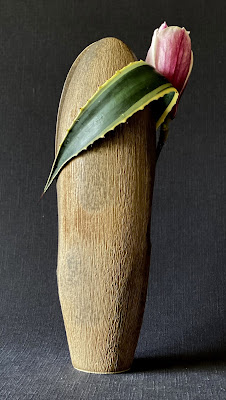 |
Monstera deliciosa flower buds and agave
|
Hello all,
First of all an explanation and an apology. I have just become aware that, on some devices, my blog looks messy. I prepare each blog on my PC, a quite old, hand-me down model from some member of my family. I spend an inordinate amount of time trying to line up the photographs and to create a more pleasing presentation. However, google is very difficult to negotiate and I, often, have to redo work that I have, already, done. I never publish a post without previewing it first. So, imagine my chagrin when I checked out last week's post on my phone, to find great big gaps between the text and photos, as well as misaligned captions. AARGH!!!
I am sorry and I will try to keep a more simple format in the hope that I will eliminate the mishaps. As you've probably guessed, I'm not very technically minded, I just fumble my way through all of this.
And now to ikebana.
I absolutely love tulips and all the bulbs I planted have now flowered. But they are uncontrollable. The arrangement, below, started out as a Variation number 4, slanting style moribana, with the hikae (tulips) at 75 degrees. A few hours later, before I had a chance to photograph it, the tulips were standing bolt upright. I must admit, I rather like this look. However, two days later and they are much taller than when I cut them and all over the place.

The next two arrangement, with the tulips in an upright position, stayed more or less the same after two days, except that they are now taller.
Some of my Green Goddess lilies, of which I have many, are huge. The arrangement, below, is over a metre in height and the length of the individual flowers is about 30cm. The Japanese flowering quince provides the line in the arrangement. And, just in case any of you are concerned that it is not in water, let me assure you that it is. In fact, there are two stems, each with its base in water and bent to create the illusion of going through the stems of the lilies.

The next arrangement is one from Book Four - A variety of Materials. It can be quite challenging, especially for the less experienced ikebanists. It is, also, the arrangement that can most look western. To avoid that, first of all its important to remember asymmetry. And secondly, to group the various materials, rather than scatter them throughout the arrangement. And thirdly, ensuring that most of the materials have small leaves or flowers, with one bold and big material as a focal point. There are, of course, other elements to be considered but following these three rules can help keep the arrangement from looking western.
 |
| Six different materials in ceramic wall container |
 |
| Flowering elm branches and Aunty Magda's strelitzia |
 |
| Geranium leaves and strelitzia |
Over the years, those of you who have been following by blog, would have read of my disappointment with my herbaceous peonies. They flower sporadically, or not at all, despite all my efforts. Earlier this year, Vicky and I travelled to the Dandenongs to purchase tree peonies from a lovely lady, called Marie. It was Trish, our Ikebana International president, that put us in contact with her. Well, we bought two each and two for Lucy, which was quite an investment for all of us. Now, I'm delighted to share with you my very first tree peony flower called 'Taiyo'. I'm tickled pink!
Bye for now,













































